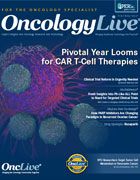Publication
Article
The Clinician’s Power
Author(s):
As cancer therapy becomes increasingly high tech, it is often easy to overlook the contributions that individual oncologists make to advancements in the eld simply by being top-notch clinicians who are observant and concerned about their patients.
OncLive Chairman,
Mike Hennessy
As cancer therapy becomes increasingly high tech, it is often easy to overlook the contributions that individual oncologists make to advancements in the eld simply by being top-notch clinicians who are observant and concerned about their patients.
Although practicing oncologists undoubtedly know of many colleagues who quietly advance care in daily practice, there are two outstanding examples in this issue of OncologyLive® of clinicians who have done so on a broad scale: Alok A. Khorana, MD, of the Cleveland Clinic, and Richard R.P. Warner, MD, recently retired from The Mount Sinai Hospital in New York City.
Dr Khorana, director of the Gastro- intestinal Malignancies Program at Cleveland Clinic’s Taussig Cancer Institute, has improved procedures for the identification and prophylactic treatment of cancer-associated venous thromboembolism (VTE), as described in our cover story, “New Take on an Old Problem: Tackling VTE With Biomarkers, Risk Models, and Novel Drugs.”
For the past 10 years, Dr Khorana has been observing and studying patterns of VTE in patients with cancer. There has not always been much of a roadmap to guide him; patients with cancer often do not participate in clinical trials where medicines typically administered for VTE are tested. Yet Dr Khorana has been able to develop a risk stratification model that has been incorporated into treatment guidelines.
When it comes to not having a roadmap to guide him, however, Dr Warner’s experience surpasses that of nearly every oncologist still practicing. Dr Warner became a doctor before oncology was even a specialty. There was certainly no identification of neuroendocrine tumors as a distinct cancer type or carcinoid syndrome as a specific condition.
Now, at age 89, he shares his reflections on the changes he has witnessed in “Unraveling Neuroendocrine Tumors: Clinician Reflects on 60 Years of Discovery,” an article that appears in our Clinical Insights section. His story is remarkable— he confirmed his first carcinoid syndrome diagnosis by traveling to Oklahoma to obtain a lung cancer specimen and he had to invent the assays he needed to appropriately evaluate patients.
That spirit of tenacity and discovery is a constant underlying theme in oncology. It all starts, however, with clinicians who care about their patients bringing their keen powers of observation to bear on difficult problems.
We are inspired by these stories. We hope you enjoy reading them.










